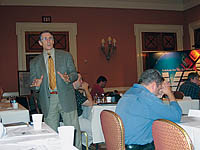
Bob Vormittag, president, kicked off the conference with an introduction to developments in the industry and company products to be introduced at the conference.
VAI addressed one of the key trends it sees in the trade - customer self-service. One of its new offerings is its System 2000 Enterprise Portal, a Web-based program that allows companies to require user logins to their sites. VAI uses the portal on its own site, tailoring it to different users and allowing access to company data, applications and contact information.
Conference attendees got as specific as they wanted at the conference during the user sessions and question and answer periods. A couple of larger ideas on general industry trends rounded out the event.
“On-Demand” Business
Paul St. Germain, segment executive/ wholesale industry, IBM Small Meeting Business group, told the group it has a head start in gearing up for the “on-demand” world by embracing technology.“If we look at customers today, how many have graduated in the past 10 years?” he asked. They are comfortable with doing the research on their own, and this is changing how the salesforce works. Customers want to do as much as they can themselves if it keeps the price down, he said. “People are willing to insert their order themselves; they're willing to forgive their own mistakes.” If distributors can't offer this to their customers, the customers can just go somewhere else.
These customers are also likely to switch to another wholesaler that is giving them an unbundled price, St. Germain said. They want to see the product price broken up from the service price, and this requires distributors to place a value on their services.
He also said logistics will play an increasing role in the distribution channel. According to the Facing the Forces of Change study by the National Association of Wholesale-Distributors, two-thirds of products went through wholesalers in 2003. That is predicted to go down to just 60% by the year 2008. Logistics companies offer a viable alternative for suppliers, St. Germain said. This is where wholesalers have an opportunity to differentiate themselves with valued services.
A number of items made St. Germain's emerging trends list, but all seem to affect distributors more indirectly than directly.
- Radio-frequency identification (RFID): While distributors maintain a complacent role by letting the manufacturers take the lead in attaching them to the products, there's a tremendous amount of interest. “If you want to fill up a room, tell people you're going to show them how it works,” he said.
- Off-shoring: From the distributors' point of view, the product is made off-shore, but it still needs to be distributed.
- Sarbanes-Oxley Act: It doesn't affect private companies that aren't planning to go public, which describes most wholesalers.
- Private-label products: These may be used to fight some of these margin battles, but what about the relationships? “Who is getting the extra margin?” St. Germain asked.

Autonomic Enterprise
Jack Shaw, author and business consultant, presented his idea of the “Autonomic Enterprise.” His concept is that an enterprise can manage itself much like the human body's nervous system automatically maintains itself.The idea of autonomic enterprising has been around for a long time, Shaw said. Companies began creating machines 75-100 years ago when people realized they could replace large numbers of people on the factory floor. As few as 10 years ago visionaries like Shaw dramatically underestimated the impact of the Internet, he said. A bandwidth explosion in recent years has resulted in 40% of American households using broadband Internet connections.
Shaw said integrating autonomic strategies with other tools such as customer service is a good compromise. He gave an example of a golf store Web site that offers online customer service allowing a customer to seek out the information he wants on the product - a golf driver in this case - and then talk to a live customer service agent through his screen and computer microphone. A quick poll of the session's attendees told Shaw that no one in the room had yet tried integrating their Web sites with customer service tools.
“Change is a constant in your organization,” Shaw said. “In fact, it's the only constant.”
It's no longer enough to accept change in business processes, he said, it's now necessary to actually seek out new opportunities in technology and change.
- Ashley Anderson
